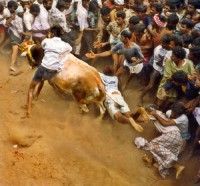

Recently I wrote on Bull fight in Spain and expressed my anguish at this sport. My writing received mixed reception but many opposed the said sport. They found it to be cruel sport and they felt that innocent bulls are made to die in 20 minutes in a very barbaric way. There is no guarantee that the spikes or the spears which are supposed to injure the hearts would injure only the heart of the bull. They may even cut the ribs or the bulls might get fractured etc. However there are many who still consider that it is a sport of courage and that the bull is not in a disadvantageous position. I always respect the views of others who do not agree with me because they have as much right to stick to their own views as I stick to my own views.
Playing with animals is an age old sport. I think during Roman times, we have read how gladiators used to fight with lions. I have now forgotten the name of the country where they force criminals to fight with ferocious dogs. These are sports which rational animal like man encounters with animals which some times may appear to show courage and at times perverse satisfaction etc.
In India we have a “sport†called Jallikattu, a traditional sport prevalent in Tamil Nadu, a state in the Republic of India. It is also called as taming of the bull. It is traditional sports conducted during the months of January to May. It is said that it has 4000 years history. Tamil Nadu people conduct this sport during a festival called Pongal. It is the thanksgiving festival celebrated in Tamilnadu. People worship the Sun God, and pray for his gifts of bounty. It is celebrated as sankrati all over the country. It is also celebrated to mark the withdrawal of the southeast monsoons as well as the reaping of the harvest. It is the biggest harvest festival celebrated in Tamil Nadu for over 3 to 4 days in the mid January each year
Let us know more about Jallikattu, It comes from the term Salli kassu (coins) and Kattu (meaning a package) tied to the horns of the bulls as the prize money. Jallikattu involves letting loose agitated bulls into large crowds of spectators with the objective to tame the bull without using any weapons and wrestle the bounty tied in between it’s horns.. Sometimes, more than one bull is let loose at the same time. It is believed that these bulls attack not because they are irritated or agitated or frightened, but because that is “ their basic natureâ€. This is the basis for that sports and to say that it does not amount to cruelty to animals. Jallikattu in other words is a display of masculine strength which individuals try to hold the hunch of the bull and cross a certain distance. Though it doesn’t involve killing of the bull, it is still viewed as causing cruelty to the animals due to traditional practices. Jallikattu has been compared to the running of the bulls that takes place in Pamplona in Spain. But the Indian system is far more dangerous. Competitors and spectators are trampled and gored every year
. These bulls which are made to participate in the sports belong to a few specific breeds of cattle. By nature. these cattle are reared in huge herds numbering in hundreds with a few cowherds tending to them. It is from these herds that calves with good characteristics and body conformation are selected and reared to become jallikattu bulls.
During this traditional ‘sport’, horns of the adorned bulls are made wet before the event and the animal is rubbed down with oil, making it more difficult to hold onto. To add to it the bulls are drugged with steroids and are sometimes made to drink alcohol in order to enrage them. The path or way through which these bulls run have double barricades in order to avoid injuries to spectators and bystanders who might be permitted to remain within the barricades The man who holds on to the bull from the entrance of the bull pen to the marker is entitled to the prizes lavishly given by the Organizers
I shall not explain in detail how the “sports†is played. In one of the reports I read what one spectator said that he saw a crowd pulling the neck of the bull with a rope, a few twisting it’s tail, someone pulling the legs backward, someone jumping on the humps, I had not seen it. This was before the courts stepped in to check this cruel part involved in the sports. I have no evidence now to say whether such mayhem is still indulged in even after the intervention of the courts.
However the “sports†was questioned in the Supreme Court of India with a Public Interest Litigation. The Supreme Court did not give permission in the year 2008 but later it gave permission on certain conditions following the state government’s plea in the face of protests against the ban. The Tamil Nadu state Assembly passed a legislation to regulate conduct of Jallikattu prescribing norms for holding such events and ensure the safety of animals, participants and spectators. In spite of that this year there were not less than three deaths and nearly 200 injuries in this sports. One should admit that the restrictions imposed by the Courts and the guidelines issued by the Governments and the norms set by law, the organizers saw to it that the bulls were not drugged or they were not intoxicated. It is a positive step for complete ban.
Another Pongal is fast approaching and again another Jallikattu for the poor bulls who must be happily grazing in fileds completely unaware of the cruelties which they will have to face to satisfy the “traditional sports of the peopleâ€. This speaks volumes about the base instincts of human beings.
